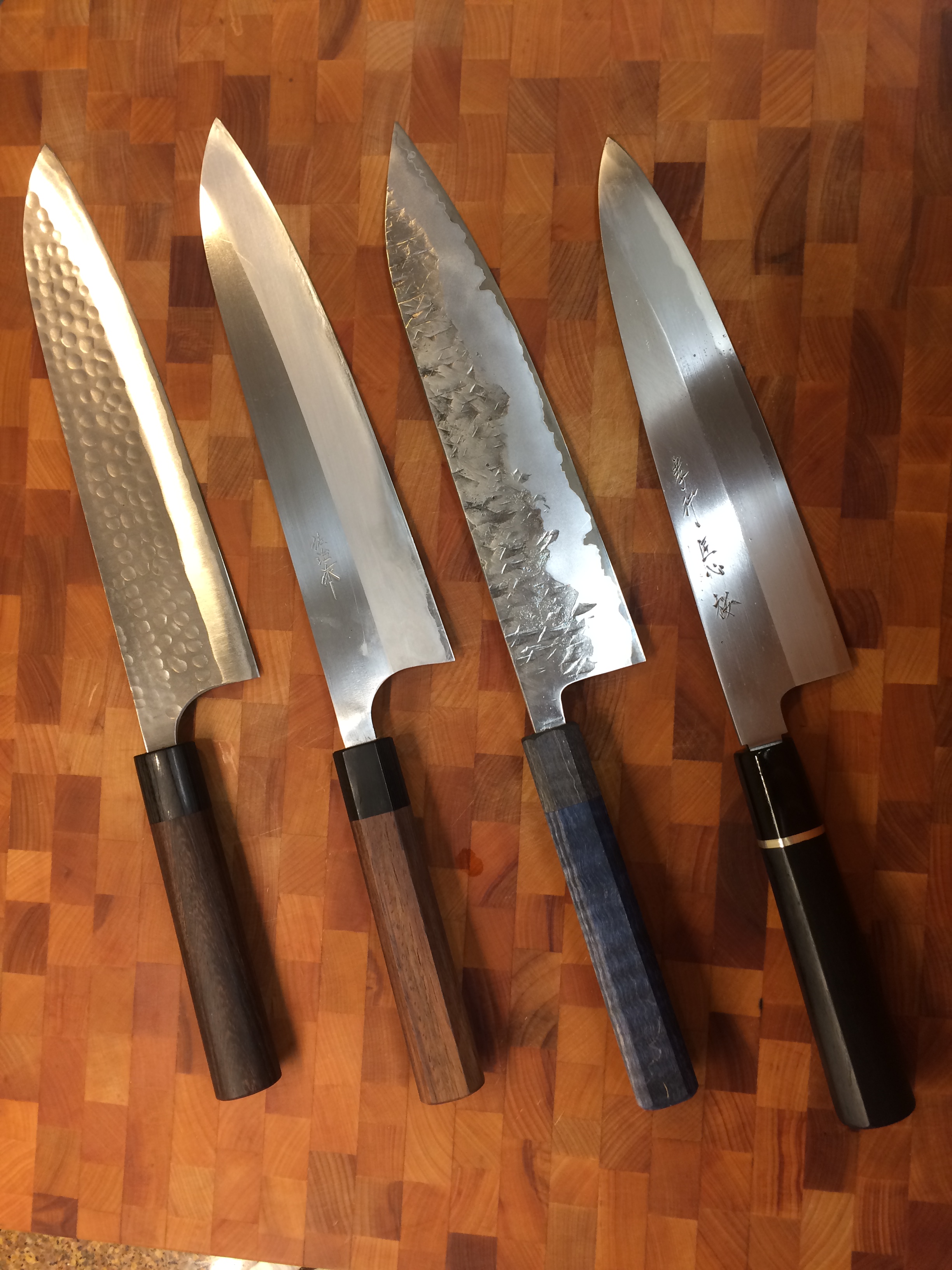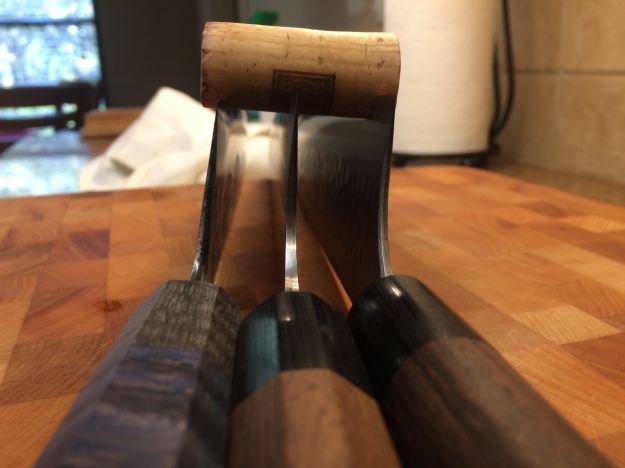Big thanks to Jeffry for letting me play with his knives. He was kind enough to loan me both this knife and the Yoshimune Shirogami #1 240mm gyuto I reviewed a couple of weeks ago.
The Saji can be found here: http://www.chefknivestogo.com/sag3gigy24.html
The Saji Ginsan gyuto has fascinated me since it first arrived at CKTG. It had a lot to recommend it.
First, the knife uses a brushed/hairline finish that I find attractive but more importantly I find the finish to be functional. Many knife finishes wear poorly becoming unattractive or even prone to accelerated wear or corrosion with normal use. Brushed finishes, while impossible to duplicate exactly, can be closely approximated by refinishing using widely available abrasives such as Scotch Brite pads and elbow grease. The brushed finish also hides minor scratching. This can be particularly important if the cladding layer, as is often the case, is soft enough to scratch using nothing more than a terrycloth towel.
Second, the Saji uses Ginsan steel. Ginsan has, in my experience, the best compromise in edge taking and edge holding of any stainless steel. Some compare AEB-L favorably with Ginsan and PM steels like R2 can certainly exceed Ginsan in edge holding. However, I’ve yet to find an AEB-L knife that can hold an edge half as long as the Ginsan knives I’ve used and Ginsan edges out R2 for keenness every time (pun intended). Full disclaimer here, all the AEB-L knives I’ve sampled were comparatively inexpensive so there is the real possibility my observations reflect the quality of craftsmanship and not the performance of the steels. Regardless, until proven otherwise, Ginsan reigns supreme among stainless steels in my estimation.
Third, and this is such a bourgeois thing to say, the knife carries a luxury price. I know, I know….sometimes, more expensive is just more expensive; and sometimes, you get what your pay for; but it’s always kind of fun to see which is which. Right? I mean we all want to test drive a Maserati if only for the perverse curiosity of it.
What I could not anticipate from the sales spiel was the geometry of the grind, the utility of the profile, and how the knife would perform in product.
On the first point, while the knife wore signs of use, the finish remained attractive and masked the wear well. Furthermore, I would have no reservation refinishing the blade should I ever find the accumulated wear sufficiently unsightly.

Left to right: Anryu Hammered, Saji, Yoshimune, Takayuki Syousin Sakura. The Takayuki was included because I recently refinished the knife using ScotchBrite pads. The knife is coated in oil for protection from oxidation so it may be difficult to see.
On the second, the Saji further reinforced my confidence in Ginsan steel. The steel took a beautiful edge quickly and easily and held it very well in my limited use.
Things get a bit dicey on the third point. I am of the opinion that there is a sizable array of knives with similar attributes and prices. Knives from the Masakage lineup, Kurosaki’s various offerings, Katsushige Anryu, Hiroshi Kato, etc have flooded the market with Hitachi steel cored knives with stainless cladding around the $250 price point. These knives are almost universally good knives suffering only to separate themselves out from the crowded field. Enter the Saji. Wearing a price well north of the median price for these would be competitors, it is incumbent upon the Saji to outperform these other knives in order to justify the premium. Unfortunately, in my opinion, it fails to do so. Much like my standing criticism of the Kanehiro line of knives, the Saji is an exceptional knife priced as though it were an exquisite luxury. Unfortunately for the Saji, we, the consumer, are spoiled for choice with knives that do not make this same error.
Geometrically, the Saji has a fairly standard gyuto profile making equally adept at most any kitchen task. The grind splits the difference between the surprisingly good Yoshimune and the more powerhouse Anryu Hammered. In fact, from a performance standpoint, this may be the Saji’s strongest claim to fame. The grinds closely resembles the Anryu’s in that it is beefy but, being a bit more svelte, it does not feel quite so…Conan about everything.

Left to right: Yoshimune, Saji, Anryu.
A side note: I am one that seems somewhat sensitive to the feel of a knife. In particular, I dislike knives with a dead feel to them. Knives using R2 seem particularly prone to this problem. While I did not find the Saji to be unpleasantly unresponsive, I immediately noticed the contrast with the Yoshimune, which did not exhibit this characteristic at all.
I can’t escape the similarities between the Kanehiro and the Saji in how I conceive of these knives. In the past I have had to defend the Kanehiro from my own criticisms. People have concluded from my negative tone about the knife that I disliked the knife. I actually own a Kanehiro AS and I love the knife. If I had it to do again though, I think there would be a more efficient way to dispose of my cutlery budget without missing out on that level of quality. The same could be said of the Saji. If you were to come into one somehow, it is a very good knife. If you are looking to buy new at full retail, I can’t escape the feeling that there would be better ways to spend your money.